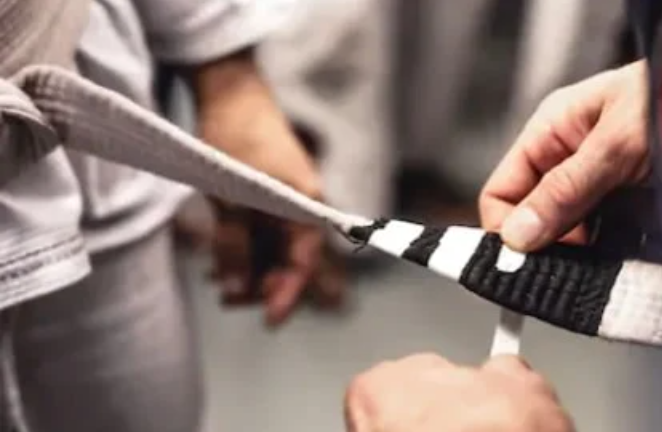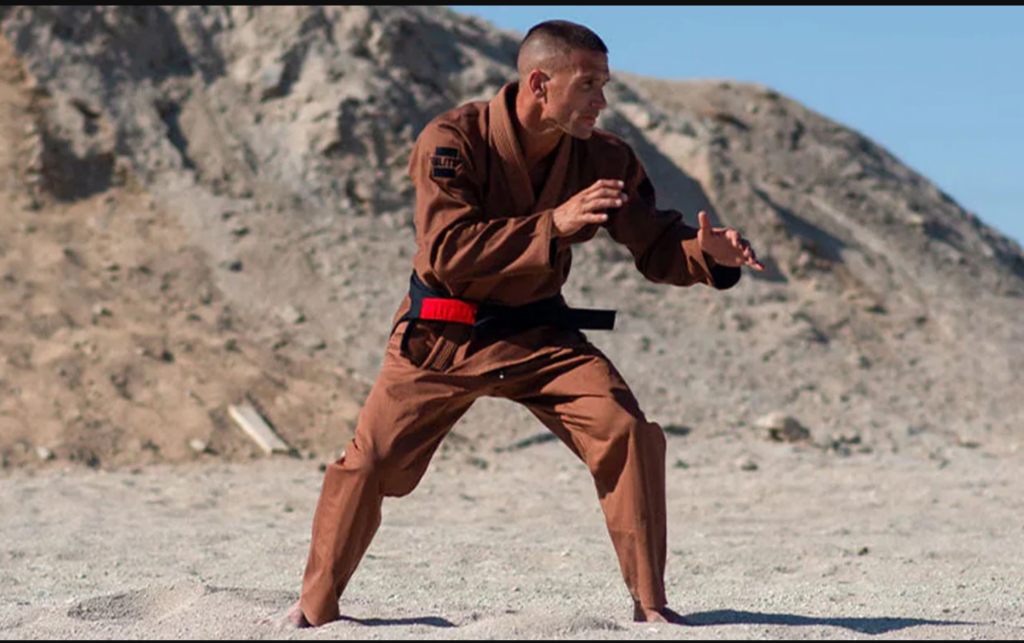

In a room full of seasoned grapplers and coral belts—some of the highest-ranking figures in Brazilian Jiu-Jitsu—a white belt took the mat and performed something most in the sport had never seen during a belt promotion: a BJJ kata.
Yes, a kata. In Brazilian Jiu-Jitsu. For a promotion.
The event, which surfaced in late October 2024, involved a BJJ white belt student being asked to demonstrate a solo kata—a structured routine of BJJ movements—in front of a panel of black and coral belts. After completing the kata, the student was awarded a stripe on his belt.
The entire scene was recorded and posted online, and the clip quickly spread across BJJ forums, social media, and message boards, where it ignited the kind of firestorm usually reserved for controversial stoppages or ADCC snubs.
One of the more restrained comments online read:
________________________________________________________________________
“What in the karate hell is going on around here?”
________________________________________________________________________
Belt Testing in BJJ: A Moving Target
To understand why this caused such a stir, it helps to know how Brazilian Jiu-Jitsu promotions usually work. The short version? There’s no standard. Every academy does things a little differently.
Some instructors run formal belt exams, some do a casual BJJ stripe ceremony, and others just tie a new belt on you in the middle of a random Tuesday night class. The one constant? Sparring. Rolling. Pressure testing.
There are no katas in Brazilian Jiu-Jitsu. Period.
Most BJJ belt promotions hinge on a student’s ability to apply techniques against resistance in live training. The technical knowledge matters, sure—but in BJJ, demonstrating those techniques against an opponent who’s trying to stop you has always been the gold standard.
Which is why the kata stripe raised so many eyebrows. It’s not that BJJ doesn’t have drills, movements, or solo repetitions—it absolutely does.
But awarding a stripe based solely on a memorized solo performance? That’s treading into territory that feels more traditional martial arts than modern grappling sport.

The Case For BJJ Kata? Hear Me Out!
Believe it or not, this isn’t the first time the kata conversation has popped up in BJJ circles. Some instructors have floated the idea of creating a standardized solo routine as a tool for beginners.
Shrimping, bridging, technical stand-ups, sprawls—many of these foundational movements can be linked together to form a flow. The idea isn’t totally absurd.
In fact, one practitioner wrote that:
________________________________________________________________________
“I was wondering if anybody has tried to create a solo routine like a kata but for BJJ… I think it’d be a good way to solo train.”
________________________________________________________________________
However, a good way to train alone and determine promotion eligibility are two very different things. The majority of the pushback online came not against the idea of movement drills but against the suggestion that they could replace the crucible of rolling with resisting partners.
What Actually Earns a Stripe?
Most promotions in BJJ consider a mix of factors: time on the mat, technical understanding, attendance, and—most importantly—performance in live sparring. There’s also room for discretion. Some coaches give stripes to encourage students. Some wait longer. Others don’t use them at all.
BJJ promotions aren’t just subjective—they’re deeply personal. Your coach’s criteria are the only criteria that matter in your gym. And that’s part of the sport’s charm and chaos.
But the introduction of kata into that mix? That’s new. That’s a step away from what BJJ has historically valued: adaptability, timing, and control under pressure.
As one high-ranking black belt put it bluntly when asked about belt exams:
________________________________________________________________________
“Every day on the mat is a belt test in my opinion.”
________________________________________________________________________

Is This the Start of Something—or Just a One-Off?
The academy where the kata was performed hasn’t released a statement, and there’s no indication this was part of a broader curriculum. It’s entirely possible this was a one-off decision—an experiment, a show of creativity, or just an attempt to add formality to the process.
However, the reaction it provoked shows how protective BJJ practitioners are about the integrity of rank. And honestly, it makes sense.
In a sport where it takes 10+ years to earn a black belt and where promotions are often as much about toughness as they are about technique, the introduction of scripted, performative elements—even as supplements—can feel like a slippery slope.
No one wants to see BJJ turn into point-fighting or board-breaking. The fear isn’t that kata will become the norm—it’s that it signals a shift toward prioritizing structure over substance.
Stripes, Standards, and Staying Real
This isn’t about gatekeeping. It’s about clarity. Promotions in Brazilian Jiu-Jitsu carry weight because of the work it takes to earn them. While innovation has its place, especially in training methods, using kata as a central metric for grading throws a wrench into a value system that’s always been built on effectiveness under fire.
If this incident was meant to start a conversation, it worked. But until a kata can pass someone’s guard and secure the back, don’t expect it to become a staple in BJJ grading anytime soon.
Man Promotes Himself to a Purple Belt in BJJ & Gives Himself a Gauntlet
BJJ Belt Gauntlet – Too Savage, Or Just “Manly” Enough?
Can You Just Decide to Self-Promote To Black Belt? Yes, Claims Roland Sarria














